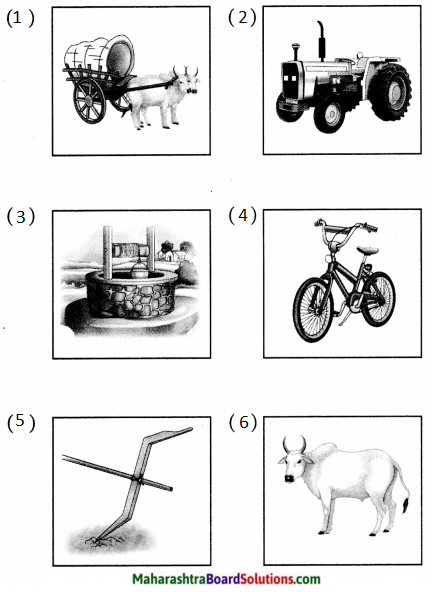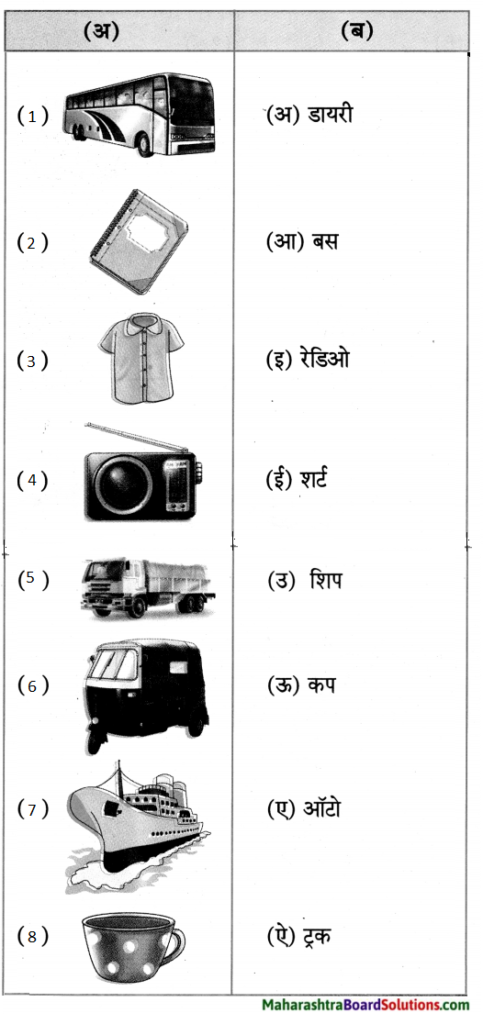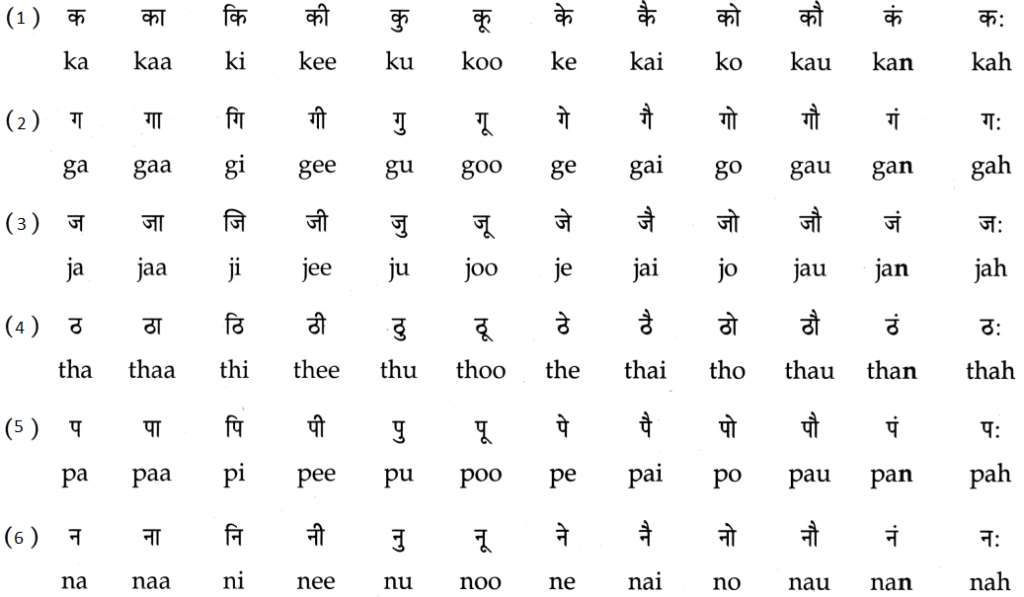Std 5 Hindi Lesson 7 (अ) बोध, (ब) समान – विरुद्ध Question Answer Maharashtra Board
Balbharti Maharashtra State Board Class 5 Hindi Solutions Sulabhbharati Chapter 7 (अ) बोध, (ब) समान – विरुद्ध Notes, Textbook Exercise Important Questions and Answers.
5th Std Hindi Poem (A) Bodha (B) Saman-viruddha Question Answer
5th Standard Hindi Digest Chapter 7 (अ) बोध, (ब) समान – विरुद्ध Textbook Questions and Answers
(अ) बोध
1. पढो, समझो और बताओ
(ब) समान – विरुद्ध
1. पढो, और समझो
![]()
Hindi Sulabhbharati Class 5 Solutions Chapter 7 (अ) बोध, (ब) समान – विरुद्ध Additional Important Questions and Answers
(अ) बोध
प्रश्न 1.
उचित जोड़ियाँ मिलाइए:
| (अ) | (ब) |
| 1. गायक | (अ) दुल्हन |
| 2. हाथी | (आ) चाची |
| 3. अध्यापक | (इ) नागिन |
| 4. भाई | (ई) हिरनी |
| 5. लेखक | (उ) गाय |
| 6. बिलाव | (ऊ) सिंहनी |
| 7. सिंह | (ए) बिल्ली |
| 8. बैल | (ऐ) लेखिका |
| 9. हिरन | (ओ) बहन |
| 10. नाग | (औ) अध्यापिका |
| 11. चाचा | (अं) हथिनी |
| 12. दूल्हा | (अ:) गायिका |
उत्तर:
| (अ) | (ब) |
| 1. गायक | (अ:) गायिका |
| 2. हाथी | (अं) हथिनी |
| 3. अध्यापक | (औ) अध्यापिका |
| 4. भाई | (ओ) बहन |
| 5. लेखक | (ऐ) लेखिका |
| 6. बिलाव | (ए) बिल्ली |
| 7. सिंह | (ऊ) सिंहनी |
| 8. बैल | (उ) गाय |
| 9. हिरन | (ई) हिरनी |
| 10. नाग | (इ) नागिन |
| 11. चाचा | (आ) चाची |
| 12. दूल्हा | (अ) दुल्हन |
![]()
प्रश्न 2.
निम्नलिखित शब्दों के लिंग परिवर्तन कीजिए:
- दादा
- बकरा
- शेर
- लड़का
- छात्र
- मोर
- मामा
- धोबी
- राजा
- घोड़ा
- मुर्गा
- बेटा
- बूढ़ा
- गुड्डा
- हंस
- ऊँट
उत्तर:
- दादी
- बकरी
- शेरनी
- लड़की
- छात्रा
- मोरनी
- मामी
- धोबिन
- रानी
- घोड़ी
- मुर्गी
- बेटी
- बुढ़िया
- गुड़िया
- हंसिनी
- ऊँटनी
प्रश्न 3.
निम्नलिखित शब्दों में से स्त्रीलिंग व पुल्लिंग शब्द छाँटकर लिखिए।
उत्तर:
| शब्द | स्त्रीलिंग | पुल्लिंग |
| 1. पत्रिका, अखबार | पत्रिका | अखबार |
| 2. डॉक्टर, सेविका | सेविका | डॉक्टर |
| 3. धोबिन, रसोइया | धोबिन | रसोइया |
| 4. पिताजी, तितली | तितली | पिताजी |
| 5. बालक, अध्यापिका | अध्यापिका | बालक |
| 6. बकरी, कुत्ता | बकरी | कुत्ता |
| 7. माली, पत्नी | पत्नी | माली |
| 8. नौकर, राजकुमारी | राजकुमारी | नौकर |
| 9. सेठानी, गायक | सेठानी | गायक |
| 10. नायिका पुरुष | नायिका | पुरुष |
![]()
प्रश्न 4.
निम्नलिखित शब्दों के बहुवचन – रूप लिखिए:
- पत्ता
- लड़का
- पैसा
- पुस्तक
- कुर्सी
- थाली
- वस्तु
- चिड़िया
- चिट्ठी
- बोतल
- आँख
- गेंद
- रात
- मेज
- गाय
- नाव
- पतंग
- बहन
- बात
- दुकान
उत्तर:
- पत्ते
- लड़के
- पैसे
- पुस्तकें
- कुर्सियाँ
- थालियाँ
- वस्तुएँ
- चिड़ियाँ
- चिट्ठियाँ
- बोतलें
- आँखें
- गेंदें
- रातें
- मेजें
- गायें
- नावें
- पतंगें
- बहनें
- बातें
- दुकानें
प्रश्न 5.
निम्नलिखित शब्द एकवचन हैं या बहुवचन? लिखिए:
- चुहिया
- फल
- माला
- मूर्तियाँ
- घंटा
- दीवारें
- सब्जी
- सड़कें
- घोड़ा
- ताला
- चूहे
- बेटा
- माताएँ
- सभा
- गुड़ियाँ
- तोता
- लताएँ
- कन्या
- महिलाएँ
- बाधा
उत्तर:
- एकवचन
- एकवचन
- एकवचन
- बहुवचन
- एकवचन
- बहुवचन
- एकवचन
- बहुवचन
- एकवचन
- एकवचन
- बहुवचन
- एकवचन
- बहुवचन
- एकवचन
- बहुवचन
- एकवचन
- बहुवचन
- एकवचन
- बहुवचन
- एकवचन
![]()
प्रश्न 6.
उचित जोड़ियाँ मिलाइए:
| (अ) | (ब) |
| 1. राखी | (अ) पपीते |
| 2. मिठाई | (आ) औषधियाँ |
| 3. रोटी | (इ) पेटियाँ |
| 4. टोपी | (ई) झाड़ियाँ |
| 5. मछली | (उ) डालियाँ |
| 6. डाली | (ऊ) मछलियाँ |
| 7. झाड़ी | (ए) टोपियाँ |
| 8. पेटी | (ऐ) रोटियाँ |
| 9. औषधि | (ओ) मिठाइयाँ |
| 10. पपीता | (औ) राखियाँ |
उत्तर:
| (अ) | (ब) |
| 1. राखी | (औ) राखियाँ |
| 2. मिठाई | (ओ) मिठाइयाँ |
| 3. रोटी | (ऐ) रोटियाँ |
| 4. टोपी | (ए) टोपियाँ |
| 5. मछली | (ऊ) मछलियाँ |
| 6. डाली | (उ) डालियाँ |
| 7. झाड़ी | (ई) झाड़ियाँ |
| 8. पेटी | (इ) पेटियाँ |
| 9. औषधि | (आ) औषधियाँ |
| 10. पपीता | (अ) पपीते |
प्रश्न 7.
सही शब्द चुनकर लिखिए:
- सोनू निगम प्रसिद्ध ………. है। (गायक / गायिका)
- …………… गहने पहनती है। (स्त्री / पुरुष)
- कक्षा में ………….. पढ़ा रही है। (अध्यापिका / अध्यापक)
- मेरा ………….. पढ़ाई कर रहा है। (बेटी / बेटा)
- ………….. खाना खा रहे हैं। (दादाजी / दादीजी)
- …………… सारा दूध पी गया। (बिल्ली / बिलाव)
- ………….. दूध देती है। (बैल / गाय)
- …………… दौड़ा। (हिरन / हिरनी)
- मेरे ………….. आए हैं। (चाची / चाचा)
- ………….. कपड़े धोता है। (धोबी / धोबिन)
उत्तर:
- गायक
- स्त्री
- अध्यापिका
- बेटा
- दादाजी
- बिलाव
- गाय
- हिरन
- चाचा
- धोबी
प्रश्न 8.
सही शब्द चुनकर लिखिए:
- वहाँ कई …………. रखी हैं। (मेजें / मेज़)
- सभी …………… बंद हैं। (दुकान / दुकानें )
- बाहर ………….. खड़ा है। (बच्चा /बच्चे)
- मेरे …………गंदे हो गए। (कपड़ा / कपड़े)
- वहाँ …………… खड़ी हैं। (बालिकाएँ / बालिका)
- ………….. दौड़ रहा है। (घोड़ा / घोड़े)
- …………… बहती हैं। (नदियाँ / नदी )
- ………….. उड़ रहा है। (तोता / तोते)
- ………….. में दाल रखी है। (कटोरी / कटोरियाँ)
- …………… जा रही है। (बुढ़िया / बुढ़ियाँ)
उत्तर:
- मेजें
- दुकानें
- बच्चा
- कपड़े
- बालिकाएँ
- घोड़ा
- नदियाँ
- तोता
- कटोरी
- बुढ़िया
![]()
प्रश्न 8.
निम्नलिखित वाक्यों में रेखांकित शब्दों के वचन/ लिंग बदलकर वाक्य पुन: लिखिए:
1. घोड़ा दौड़ रहा है।
घोड़े दौड़ रहे हैं।
2. वहाँ थाली रखी है।
वहाँ थालियाँ रखी हैं।
3. मामाजी आए हैं।
मामीजी आई हैं।
4. राम अच्छा गायक है।
सीता अच्छी गायिका है।
(ब) समान – विरुद्ध
प्रश्न 1.
निम्नलिखित शब्दों के समानार्थी शब्द लिखिए:
- केश
- मयूर
- पेड़
- सूर्य
- कृपा
- ध्वज
- खटिया
- गृह
- दर्द
- आँख
- पंछी
- पुष्प
- द्वार
- सवेरा
- अँधेरा
- शरीर
- आकाश
- पर्वत
- ईश्वर
- इच्छा
उत्तर:
- बाल
- मोर
- वक्ष
- सरज
- मेहरबानी
- झंडा
- चारपाई
- घर
- तकलीफ
- नयन
- पक्षी
- फूल
- दरवाज़ा
- सुबह
- अंधकार
- बदन
- गगन
- पहाड़
- भगवान
- चाह
प्रश्न 2.
निम्नलिखित शब्दों के विरुद्धार्थी शब्द लिखिए:
- आगे
- ऊपर
- सोना
- गुण
- जन्म
- भारी
- गरम
- सुखी
- बंद
- छोटा
- दिन
- कम
- आदान
- उदय
- परदेश
उत्तर:
- पीछे
- नीचे
- जागना
- दोष
- मृत्यु
- हल्का
- ठंडा
- दुखी
- खुला
- बड़ा
- रात
- ज्यादा
- प्रदान
- अस्त
- स्वदेश
![]()
प्रश्न 3.
रिक्त स्थानों में सही विरुद्धार्थी शब्द लिखिए:
- मेरे कपड़े गीले नहीं,………….. हैं।
- मेरा घर नया नहीं, ………….. है।
- हलवा तीखा नहीं, ………….. होता है।
- वह स्वदेश में नहीं, …………… में काम करता है।
- यह सच नहीं, …………… है।
उत्तर:
- सूखे
- पुराना
- मीठा
- विदेश
- झूठ
प्रश्न 4.
उचित जोड़ियाँ मिलाइए:
| (अ) | (ब) |
| 1. बाग | (अ) प्यार |
| 2. चतुर | (आ) जल |
| 3. चमक | (इ) स्वच्छ |
| 4. तालाब | (ई) दिवस |
| 5. दिन | (उ) सरोवर |
| 6. निर्मल | (ऊ) ज्योति |
| 7. पानी | (ए) चालाक |
| 8. प्रेम | (ऐ) बगीचा |
उत्तरः
| (अ) | (ब) |
| 1. बाग | (ऐ) बगीचा |
| 2. चतुर | (ए) चालाक |
| 3. चमक | (ऊ) ज्योति |
| 4. तालाब | (उ) सरोवर |
| 5. दिन | (ई) दिवस |
| 6. निर्मल | (इ) स्वच्छ |
| 7. पानी | (आ) जल |
| 8. प्रेम | (अ) प्यार |
(अ) बोध, (ब) समान – विरुद्ध Summary in Hindi
पाठ का परिचयः
प्रस्तुत पाठ का उद्देश्य विद्यार्थियों को वचन एवं लिंग बोधक शब्दों से परिचित कराना है । जिस शब्द से किसी एक व्यक्ति, एक वस्तु का बोध हो, उसे एकवचन कहते हैं। जैसे – बिल्ली, लड़की, लड़का। जिस शब्द से एक से अधिक व्यक्ति तथा वस्तु का बोध हो, उसे बहुवचन कहते हैं। जैसे – बिल्लियाँ, लड़कियाँ, लड़के।
![]()
शब्दार्थ:
1. समानार्थी – similar, synonyms
2. विरुद्धार्थी – opposites, antonyms
Hindi Sulabhbharati 5th Standard Pdf दूसरी इकाई
- गाँव और शहर Class 5 Hindi Question Answer
- जीवन Class 5 Hindi Question Answer
- भाई-भाई का प्रेम Class 5 Hindi Question Answer
- बालिका दिवस Class 5 Hindi Question Answer
- रोबोट Class 5 Hindi Question Answer
- जुड़े हम Class 5 Hindi Question Answer
- (अ) बोध, (ब) समान – विरुद्ध Class 5 Hindi Question Answer
- बीज Class 5 Hindi Question Answer
- मुझे पहचानो Class 5 Hindi Question Answer

 उत्तर:
उत्तर:


